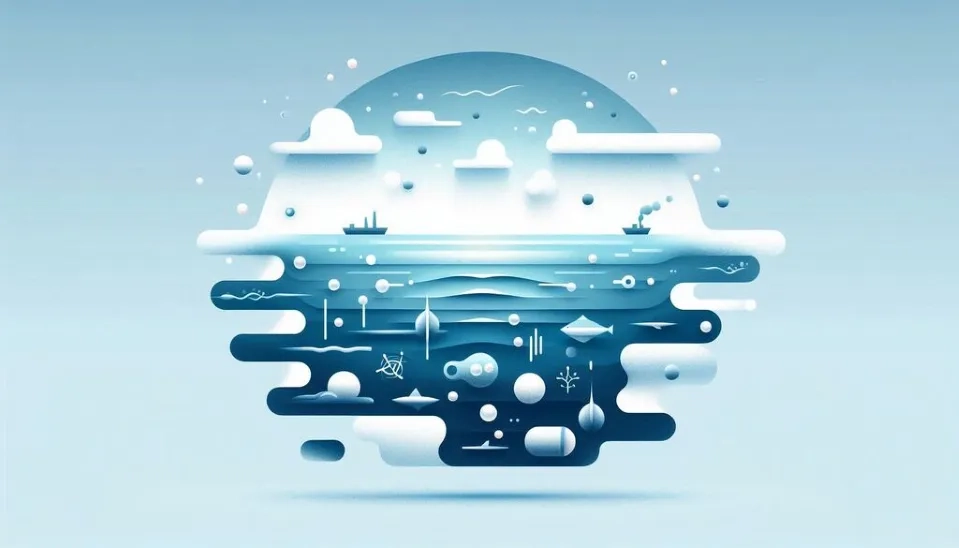
Today, approximately 80% of the human population is facing water issues (Kılıç, 2021). Water pollution has become one of the main global problems that causes deaths and diseases worldwide and can harm human and living health. Water pollution is the name given to the pollution seen in surface or groundwater. Due to water pollution, about 14,000 people die every day (Chaudhry and Malik, 2017). In agriculture, livestock production, hydropower generation, forestry, fisheries, industrial activities, etc. (Gupta, 2016), both groundwater and surface water resources play a key role. However, some industries, mining places, agriculture, and urban environments threaten the surface water quality by adding substances to the surface water, changing the physical, chemical, and biological properties of the water, and destroying its natural structure (Dwivedi, 2017). In recent decades, scientists have mainly focused on this issue, and several studies have been carried out. Due to water pollution and the global scarcity of water resources, it is essential to properly preserve surface water quality and be aware of the causes of pollution in surface water.
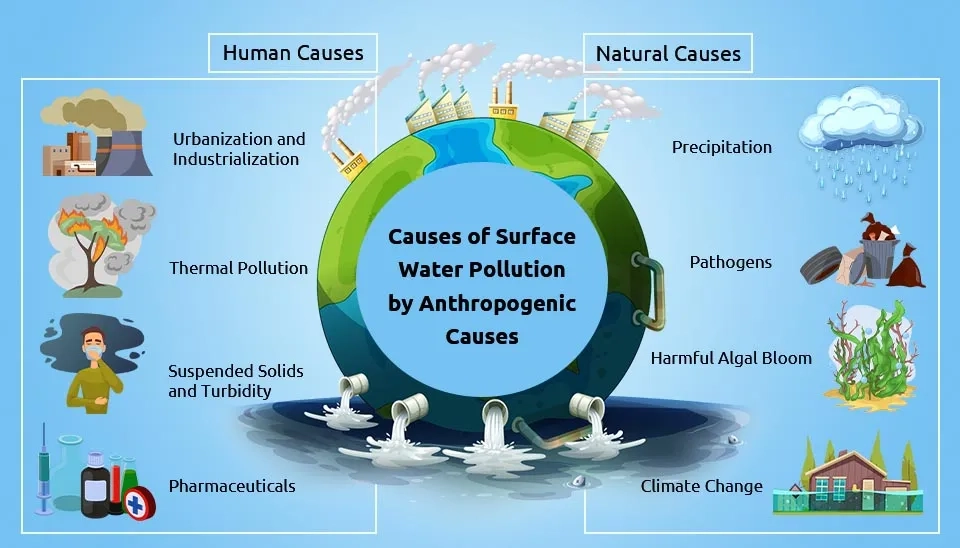
1. Surface Water Pollution
There are two main water sources on the earth: (1) surface water, which is the water we see in oceans, lakes, rivers, and ponds; and (2) groundwater, which is stored underground in Earth’s aquifers. Many species (plants and animals) depend on both the quality and quantity of the surface water for their survival (Kılıç, 2021). Several factors, like precipitation, vegetation, climate, flow conditions, urbanization, and industrialization, can affect the surface water quality. Among these factors, point sources of industries and municipalities are known to be the greatest threat to water quality. The quality of surface water is also influenced by mining activities, urban development, and agriculture (Florescu et al., 2010). Unfortunately, surface water pollution is a very serious issue in both developed and developing countries. The purpose of this article is to discuss the reasons for pollution in surface water.
2. Types of Water Pollutants
There are different types of pollutants with different properties. Contaminants can cause adverse and undesirable effects on the surface water, leading to short-term (biodegradable) or long-term damage (Chaudhry and Malik, 2017). Water pollutants can be (1) inorganic water pollutants and (2) organic water pollutants.
Inorganic water pollutants are mostly produced by silt from surface run-off; heavy metals from acid mine drainage; slash and burning practices and land filling; fertilizers from agricultural waste, which consists of phosphates, nitrates, etc.; logging; and chemical waste from industries.
Organic water pollutants consist of bacteria from livestock farming waste, organohalides, insecticides and herbicides, pathogens, food processing sewage, volatile organic compounds, etc. (Gupta, 2016).
3. Causes of Surface Water Pollution
The risk of water pollution is increasing due to population growth and technological development. There are two sources of water pollution (due to urbanization and industrialization): (1) point sources and (2) non-point sources. Point-source pollution is related to discharges from a single source. In other words, point sources of pollution are those that have a direct, identifiable source, such as an oil spill from a tanker, a pipe attached to a factory, or sewage coming out of industries. The main sources of pollution are municipal and industrial wastewater as well as storm sewer discharge. However, non-point sources of pollution enter the water bodies from different, non-identifiable sources (e.g., runoff from agricultural fields, urban waste, etc.). Substances like nutrients, fertilizers, sediments, toxic contaminants, pesticides, etc. are known to be non-point sources of water pollution (U.S. EPA, 2000; Florescu et al., 2010; Gupta, 2016; Kılıç, 2021).
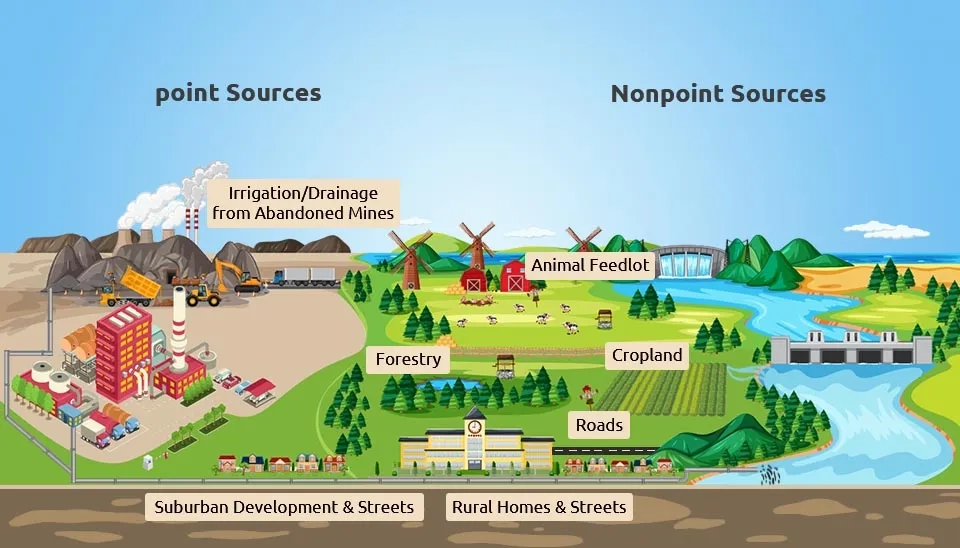
Water pollution describes a situation in which the high level of contaminants in the water prevents users from consuming it. Pollution sources can be physical factors of the environment or chemical parameters. For example, the temperature of the surface water can be changed by discharging heated water from a power plant. Biological substances like pathogenic microorganisms can also be considered pollutants (Walker et al., 2019). In general, the main sources and the causes of pollution in surface water are: domestic and municipal sewage, population growth, urbanization, construction, agriculture, mining, industrialization (paper and pulp, textiles, sugar, etc.), radioactive waste, eutrophication, pesticides and fertilizers, plastics and polythene bags, nutrient enrichment, oil spillage, sediments, thermal pollution, acid rain pollution, algae and bacteria, climate change, etc. The polluted water has an intolerable smell and less flora and fauna (Kamble, 2014; Carpenter et al., 1998). Some of the human and natural causes of surface water contamination are discussed in the following:
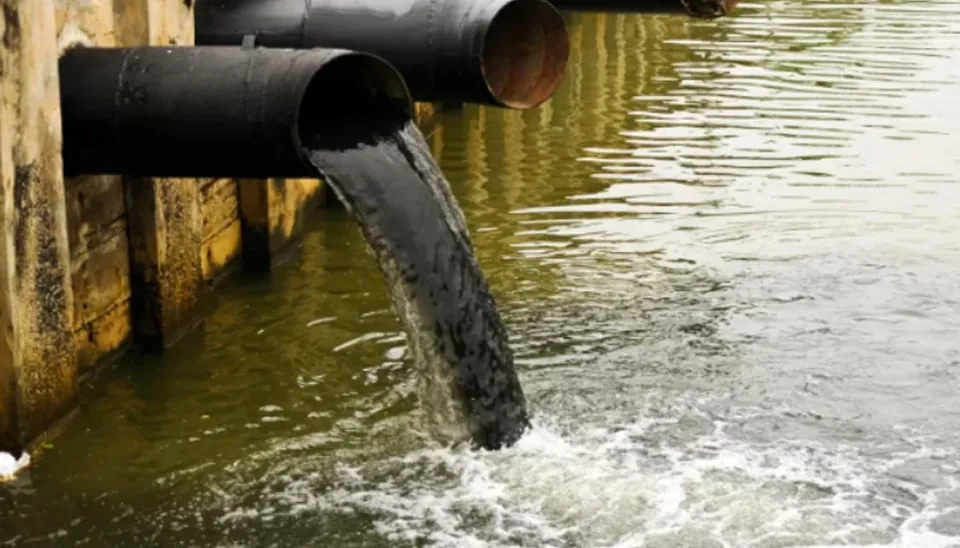
3.1. Human Causes
The activities of humans generally contribute to water pollution. Population growth and agricultural and industrial practices are the main surface water pollution causes, which becomes even worse with overcrowding in urban areas (Owa, 2013). Some of the human causes of surface water pollution are discussed in the following:
3.1.1. Urbanization and Industrialization
Population growth and deforestation cause an increase in solid waste generation, which results in more pollution (Jaben et al., 2011). Human excreta also contaminates the water, whether it is surface or underground. The polluted water contains a large number of bacteria and other man-made chemicals (e.g., heavy metals, pesticides, etc.) that can be harmful for human health and can create serious environmental issues. These pollutants can be formed during domestic, industrial, and agricultural use (Tóth, 2009). Domestic and municipal waste can cause 75% to 80% of the water pollution. Domestic sewage contains toxicants, solid waste, plastic litter, and bacterial contaminants that enter the surface water and cause pollution. Untreated industrial waste that drains into the water is also another cause of surface water pollution (Desai and Vanitaben, 2014). With urbanization growth, surface water pollution occurs in different ways and mostly it is inorganic pollution. For example, sewage from households goes into the rivers if there is not a proper drainage system or the use of plastic and other non-biodegradable materials, which will be left in the water bodies (Evans et al., 2012).
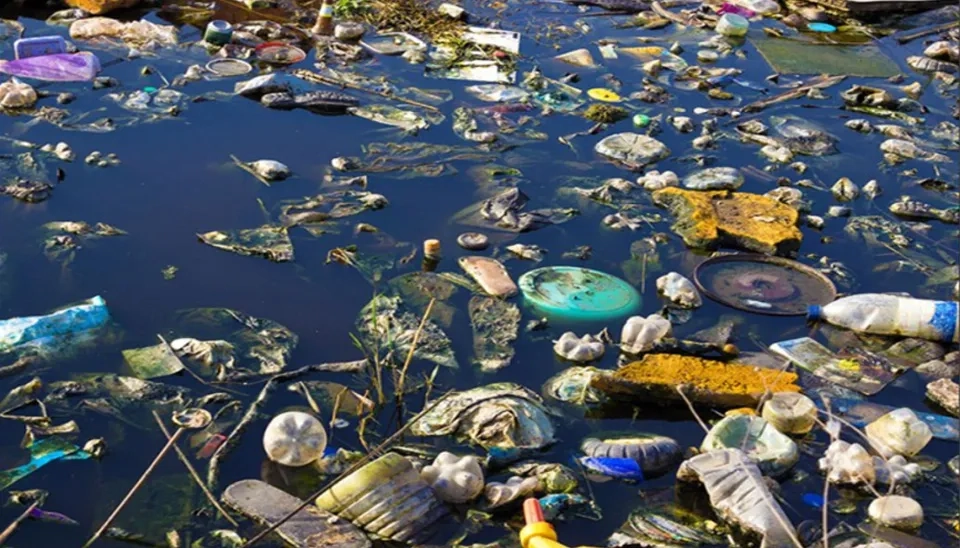
3.1.2. Thermal Pollution
Due to the discharging of hot water into surface water by some industries, the temperature of the water increases, which is known as thermal pollution. Some industries, such as nuclear power, power generators, etc., that use water as a coolant are the main ones causing thermal pollution, which is mostly inorganic pollution. The bacterial population has also been reported to be reduced in response to thermal pollution. In addition to the oxygen content in water, temperature also affects the electrical conductance of water (Paul and Meyer, 2001).
For deeper insights into the “Aquatic Thermal Pollution” explore the full article.
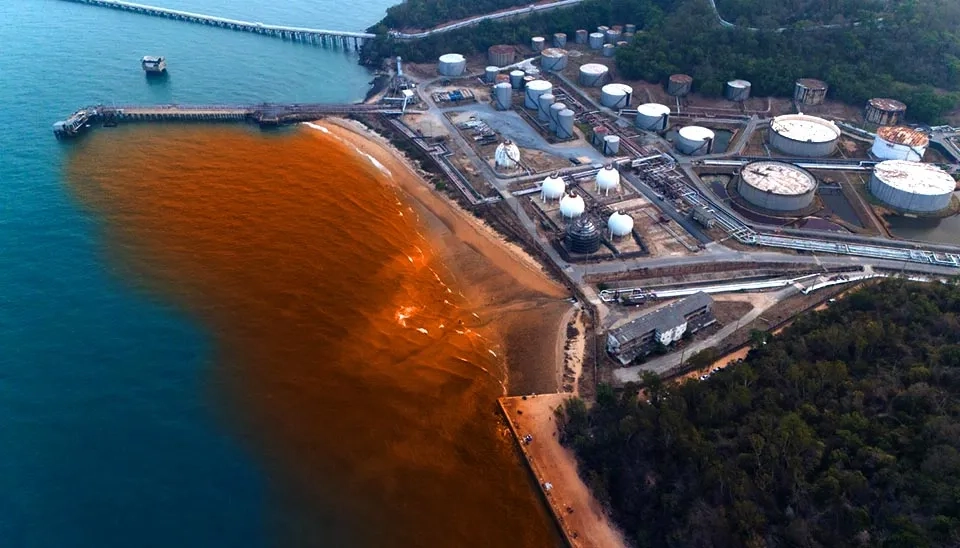
3.1.3. Suspended Solids and Turbidity
One of the most important pollutants in the water is known to be Total Suspended Solids (TSS). Some of the rivers and streams naturally contain TSS levels without any human intervention. However, due to the increase in TSS levels, water bodies cannot support a diversity of aquatic life. In addition, TSS absorbs heat, which leads to an increase in the surface water temperature. Due to the consumption of organic matter by respiring bacteria, suspended solids can also reduce the amount of Dissolved Oxygen (DO).
Turbidity is related to suspended sediments. In particular, the quantification of the light, scattered or absorbed rather than passing through the water, is referred to as turbidity. It is another measure of water clarity but not suitable for dissolved solids’ measurement, which adds color to the water. Generally, particulates, including clay, algae, silt, organic matter, microorganisms, and any other particulate substances that adsorb or scatter light, can cause turbidity (Walker et al., 2019). These two pollutants mostly cause inorganic pollution.
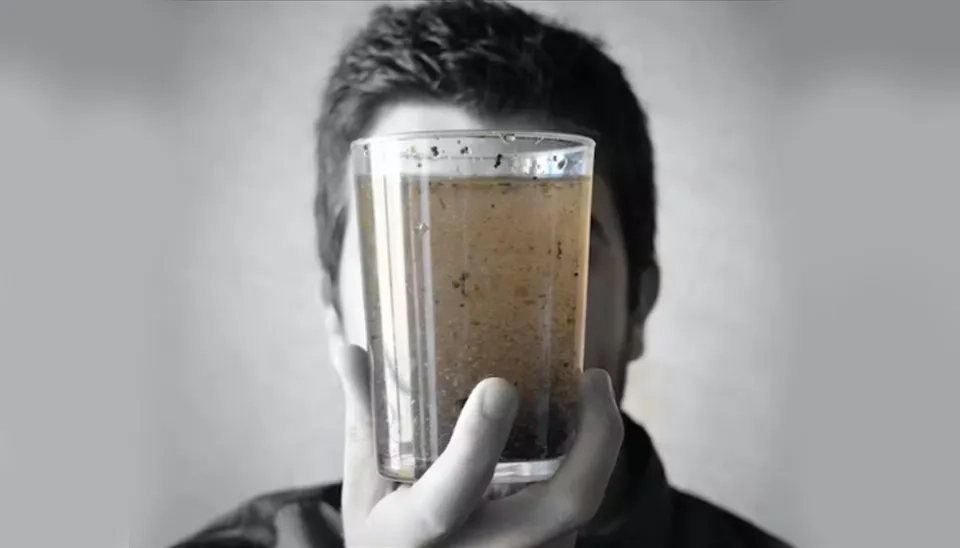
3.1.4. Pharmaceuticals
Pharmaceuticals are complex molecules that may be resistant to conventional water and wastewater treatment and persist in the environment. Pharmaceutical compounds can be found at low or moderate concentrations in surface water. However, even low concentrations of pharmaceuticals will have long-term impacts on human health or aquatic life. Therefore, it is important to consider the possible consequences of the antibiotics in the surface water (Sapkota et al., 2008; Taylor et al., 2011). The presence of pharmaceutical compounds in water bodies is a problem worldwide, and due to location and population consumption, their concentration varies. Carbamazepine is the most commonly detected drug in surface water (Rivera-Utrilla et al., 2013). This pollutant mostly cause inorganic pollution
For deeper insights into the “Pharmaceutical Wastewater Treatment” explore the full article.
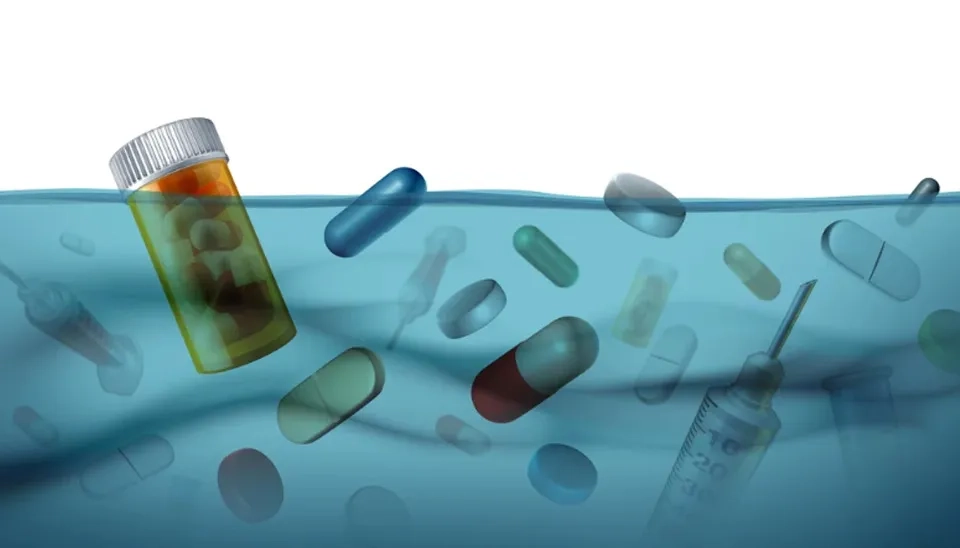
3.2. Natural Causes
Surface water pollution could occur due to some of the natural sources. However, compared to human activities, the natural causes are less important and have less impact on the water. In the following, two natural causes of pollution are described.
3.2.1 Precipitation
The water that comes to earth by precipitation is not always pure. Near the coast, it contains particulate matter and dissolved sea salts, and farther inland, it contains acids and organic compounds that are added to the atmosphere by human activities and natural processes. Other natural atmospheric pollutants that can lead to surface water pollution (organic pollution) via precipitation are gases from geological activity and gases from plant growth and decay. The acid rain issue in some countries is an example of anthropogenically derived atmospheric pollutants that can cause surface water pollution (Walker et al., 2019).
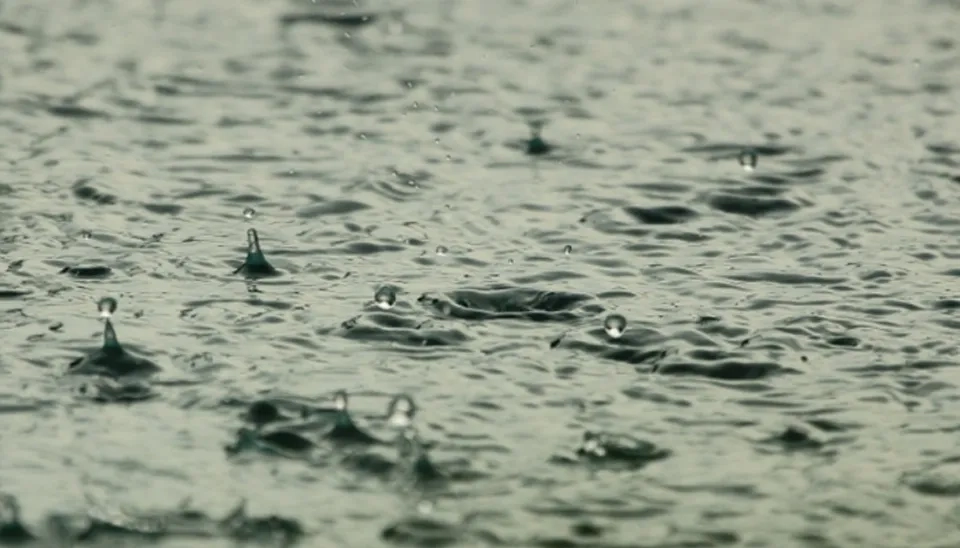
3.2.2. Pathogens
Pathogens that are present in the surface water can be harmful for human health. For providing drinking water, sufficient surface water treatment is required. If there is a high level of pathogens in the surface water, more treatment should be applied. Moreover, it is very difficult to remove all pathogens from the water, especially after heavy rains, when the number of pathogens and suspended solids increases. Other sources of pathogens in surface waters include animal feeding operations, urban stormwater, sewage treatment plants, etc. (Walker et al., 2019) which causes organic pollution.
If you want to learn more about “Drinking Water Standards”, click here.
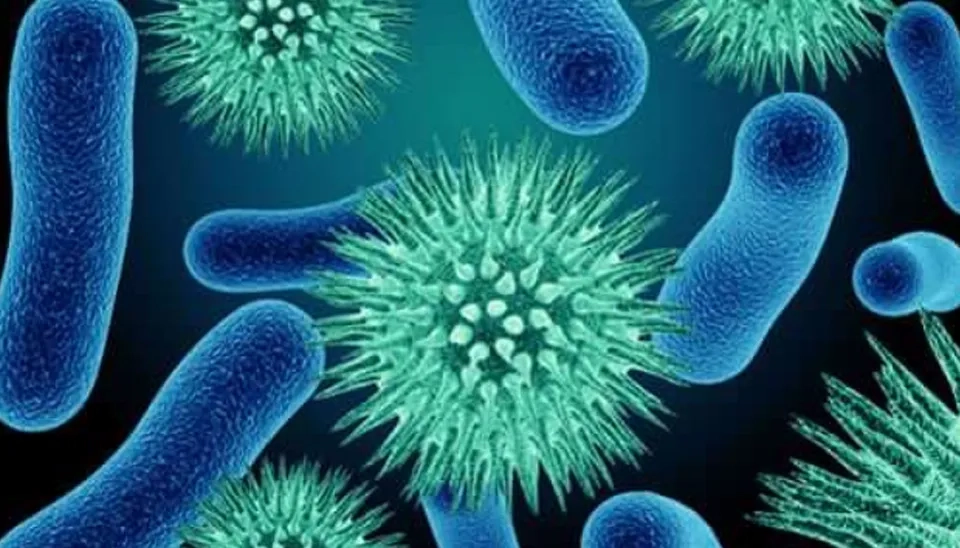
3.2.3. Harmful Algal Bloom
The main effect of eutrophication is harmful algal blooms. The algal bloom can cause significant ecological damage and be a very serious problem for users. In eutrophicated waters, the excessive growth of algae is followed by the generation of a large biomass of dead algae. These dead algae are then broken down by bacteria using oxygen, which leads to their sinking to the bottom of the waterbody (organic pollution). Because of the overconsumption of oxygen, other aquatic species, like fish, will eventually die due to the lack of oxygen (Fakron, 2022).
If you want to learn about “Algal Bloom Causes” and “Algal Bloom Control”, click here.

3.2.4. Climate Change
Although it is proven that the temperature will increase in the future, the likely impacts of climate change on surface water quality due to changes in precipitation is less studied. Climate change may cause more hydrological extremes with flooding episodes and more drought. Climate change has some negative impacts on surface water and freshwater ecosystems in terms of their hydrological regimes, nutrient status, transmission of toxic compounds, hydromorphology, etc. (Kundzewicz et al., 2007) (organic pollution). In addition, an increase in surface water temperature is one of the most rapid reactions to climate change. Some efforts, like reducing emissions or designing adaptation strategies in different sectors, can decrease the impact of climate change (Whitehead et al., 2009).
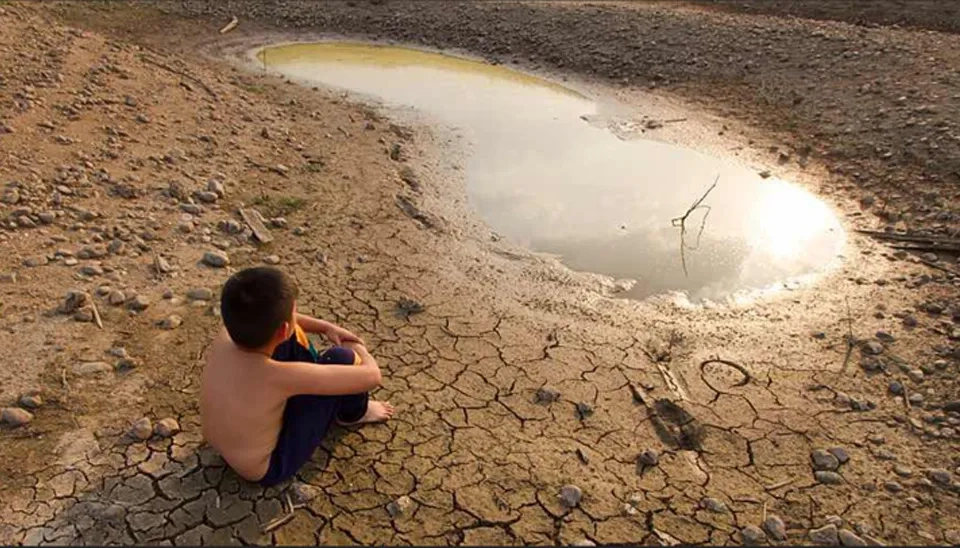
4. Effects of Surface Water Pollution
Surface water pollution has a negative impact on the entire ecosystem, especially humans and aquatic life. An increase in water pollution has a negative impact on plant growth since the minerals that are needed for photosynthesis cannot be obtained properly. The algal bloom does not allow fish and other marine species to take oxygen, which negatively affects the ecosystem (Kılıç, 2021). Freshwater is a valuable resource and can be easily polluted. Unfortunately, it is expensive and difficult to restore the freshwater quality. In addition, contaminated water causes viral, bacterial, and parasitic diseases in the human body. Microorganisms such as Shigella sp., Escherichia coli, Salmonella sp., etc. play an important role in surface water quality with regard to waterborne diseases (Adetunde and Glover, 2010). Heavy metals, including arsenic, lead, mercury, fluoride, cadmium, nitrates, and chlorinated solvents, are very dangerous for human health. These types of chemicals can cause typhoid fever, gastroenteritis, dysentery, respiratory cancer, chromosomal aberrations, arsenic skin lesions, kidney disease, and neurological damage to humans (Gupta, 2016).
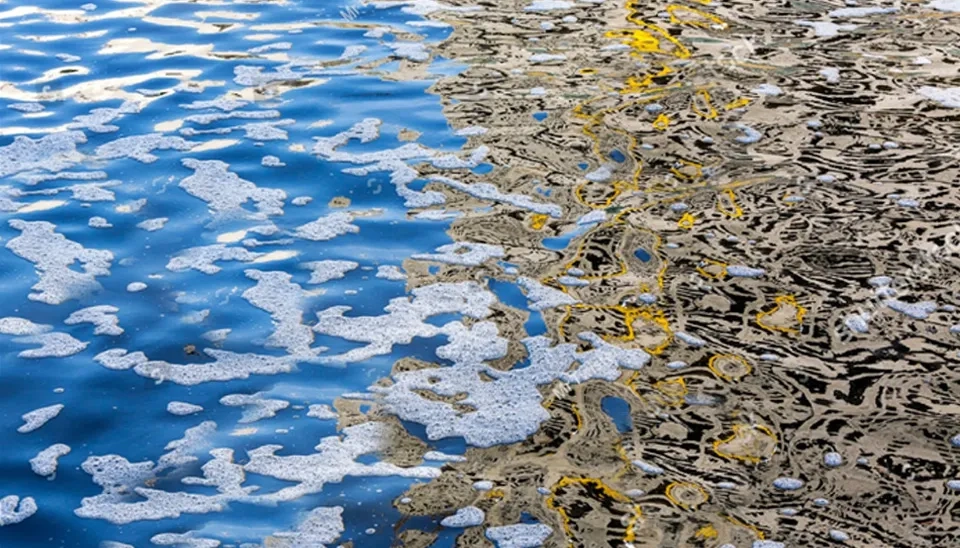
5. Conclusion
Surface water pollution causes many negative effects, like diseases, the death of aquatic animals, and the destruction of ecosystems. There are several sources, either pointed or non-pointed, which are causes of surface water contamination, which were discussed in this article. The biggest cause of water pollution is industrialization, population growth, and human activities like agriculture, municipal waste, etc. Therefore, a collaborative effort is needed among all the countries to address the causes of surface water pollution.
